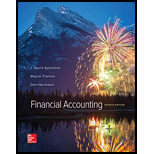
Financial Accounting
4th Edition
ISBN: 9781259307959
Author: J. David Spiceland, Wayne M Thomas, Don Herrmann
Publisher: McGraw-Hill Education
expand_more
expand_more
format_list_bulleted
Question
Chapter 12, Problem 12.8APEM
1)
To determine
To classify: Decrease in the allowance for uncollectible accounts as conservative or aggressive accounting practice.
To determine
To classify: a reversal in the previous write down of inventory accounts as conservative or aggressive accounting practice.
To determine
To classify: An increase in the estimated useful life used to calculate
To determine
To classify: A decrease in the liability reported for litigation as conservative or aggressive accounting practice.
2)
To determine
If there is a Common thing for all of the adjustments mentioned
3)
To determine
The way the company’s cash balance is affected by the adjustments mentioned
4)
To determine
The concern about the earnings management of the company due to year-end adjustments
Expert Solution & Answer
Want to see the full answer?
Check out a sample textbook solution
Students have asked these similar questions
The company's total assets are
Right Answer
Provide answer this financial accounting question answer will be accurate and step by step calculation
Chapter 12 Solutions
Financial Accounting
Ch. 12 - Prob. 1RQCh. 12 - Prob. 2RQCh. 12 - Prob. 3RQCh. 12 - Prob. 4RQCh. 12 - 5.In performing horizontal analysis, why is it...Ch. 12 - Prob. 6RQCh. 12 - Prob. 7RQCh. 12 - Prob. 8RQCh. 12 - Prob. 9RQCh. 12 - Prob. 10RQ
Ch. 12 - Prob. 11RQCh. 12 - Prob. 12RQCh. 12 - Prob. 13RQCh. 12 - Prob. 14RQCh. 12 - Prob. 15RQCh. 12 - Prob. 16RQCh. 12 - Prob. 17RQCh. 12 - Prob. 18RQCh. 12 - Prob. 19RQCh. 12 - Prob. 20RQCh. 12 - Prob. 12.1BECh. 12 - Prob. 12.2BECh. 12 - Prob. 12.3BECh. 12 - Prob. 12.4BECh. 12 - Prob. 12.5BECh. 12 - Universal Sports Supply began the year with an...Ch. 12 - Prob. 12.7BECh. 12 - Prob. 12.8BECh. 12 - Prob. 12.9BECh. 12 - Prob. 12.10BECh. 12 - Prob. 12.11BECh. 12 - Prob. 12.12BECh. 12 - Prob. 12.13BECh. 12 - Classify each of the following accounting...Ch. 12 - Classify each of the following accepted accounting...Ch. 12 - Prob. 12.1ECh. 12 - Prob. 12.2ECh. 12 - Prob. 12.3ECh. 12 - Prob. 12.4ECh. 12 - Prob. 12.5ECh. 12 - Refer to the information for Adrian Express in...Ch. 12 - Prob. 12.7ECh. 12 - Calculate profitability ratios (LO124) Refer to...Ch. 12 - Prob. 12.9ECh. 12 - The income statement for Stretch-Tape Corporation...Ch. 12 - Prob. 12.11ECh. 12 - LeBrons Bookstores has two divisions, books and...Ch. 12 - Prob. 12.13ECh. 12 - Prob. 12.14ECh. 12 - Distinguish between conservative and aggressive...Ch. 12 - Prob. 12.1APCh. 12 - Prob. 12.2APCh. 12 - Prob. 12.3APCh. 12 - Prob. 12.4APCh. 12 - Prob. 12.5APCh. 12 - Prob. 12.6APCh. 12 - Game-On Sports operates in two distinct segments:...Ch. 12 - Prob. 12.2BPCh. 12 - Prob. 12.3BPCh. 12 - Prob. 12.4BPCh. 12 - Prob. 12.5BPCh. 12 - Prob. 12.6BPCh. 12 - Prob. 12.1APCPCh. 12 - Prob. 12.2APFACh. 12 - Prob. 12.3APFACh. 12 - Prob. 12.4APCACh. 12 - Prob. 12.5APECh. 12 - Prob. 12.7APWCCh. 12 - Prob. 12.8APEM
Knowledge Booster
Similar questions
- Please solve this question General accounting and step by step explanationarrow_forwardThe overhead assigned to each unit of product A would bearrow_forwardRK Co. sells snowboards. Each snowboard requires direct materials for $140, direct labor for $55, and variable overhead of $64. The company expects fixed overhead costs of $673,000 and fixed selling and administrative costs of $160,000 for the next year. It expects to produce and sell 11,900 snowboards in the next year. What will be the selling price per unit if RK uses a mark-up of 17% of the total cost? Answerarrow_forward
arrow_back_ios
SEE MORE QUESTIONS
arrow_forward_ios
Recommended textbooks for you
 Financial AccountingAccountingISBN:9781305088436Author:Carl Warren, Jim Reeve, Jonathan DuchacPublisher:Cengage Learning
Financial AccountingAccountingISBN:9781305088436Author:Carl Warren, Jim Reeve, Jonathan DuchacPublisher:Cengage Learning Excel Applications for Accounting PrinciplesAccountingISBN:9781111581565Author:Gaylord N. SmithPublisher:Cengage Learning
Excel Applications for Accounting PrinciplesAccountingISBN:9781111581565Author:Gaylord N. SmithPublisher:Cengage Learning Auditing: A Risk Based-Approach (MindTap Course L...AccountingISBN:9781337619455Author:Karla M Johnstone, Audrey A. Gramling, Larry E. RittenbergPublisher:Cengage Learning
Auditing: A Risk Based-Approach (MindTap Course L...AccountingISBN:9781337619455Author:Karla M Johnstone, Audrey A. Gramling, Larry E. RittenbergPublisher:Cengage Learning Survey of Accounting (Accounting I)AccountingISBN:9781305961883Author:Carl WarrenPublisher:Cengage Learning
Survey of Accounting (Accounting I)AccountingISBN:9781305961883Author:Carl WarrenPublisher:Cengage Learning Cornerstones of Financial AccountingAccountingISBN:9781337690881Author:Jay Rich, Jeff JonesPublisher:Cengage Learning
Cornerstones of Financial AccountingAccountingISBN:9781337690881Author:Jay Rich, Jeff JonesPublisher:Cengage Learning College Accounting (Book Only): A Career ApproachAccountingISBN:9781337280570Author:Scott, Cathy J.Publisher:South-Western College Pub
College Accounting (Book Only): A Career ApproachAccountingISBN:9781337280570Author:Scott, Cathy J.Publisher:South-Western College Pub

Financial Accounting
Accounting
ISBN:9781305088436
Author:Carl Warren, Jim Reeve, Jonathan Duchac
Publisher:Cengage Learning

Excel Applications for Accounting Principles
Accounting
ISBN:9781111581565
Author:Gaylord N. Smith
Publisher:Cengage Learning

Auditing: A Risk Based-Approach (MindTap Course L...
Accounting
ISBN:9781337619455
Author:Karla M Johnstone, Audrey A. Gramling, Larry E. Rittenberg
Publisher:Cengage Learning

Survey of Accounting (Accounting I)
Accounting
ISBN:9781305961883
Author:Carl Warren
Publisher:Cengage Learning

Cornerstones of Financial Accounting
Accounting
ISBN:9781337690881
Author:Jay Rich, Jeff Jones
Publisher:Cengage Learning

College Accounting (Book Only): A Career Approach
Accounting
ISBN:9781337280570
Author:Scott, Cathy J.
Publisher:South-Western College Pub